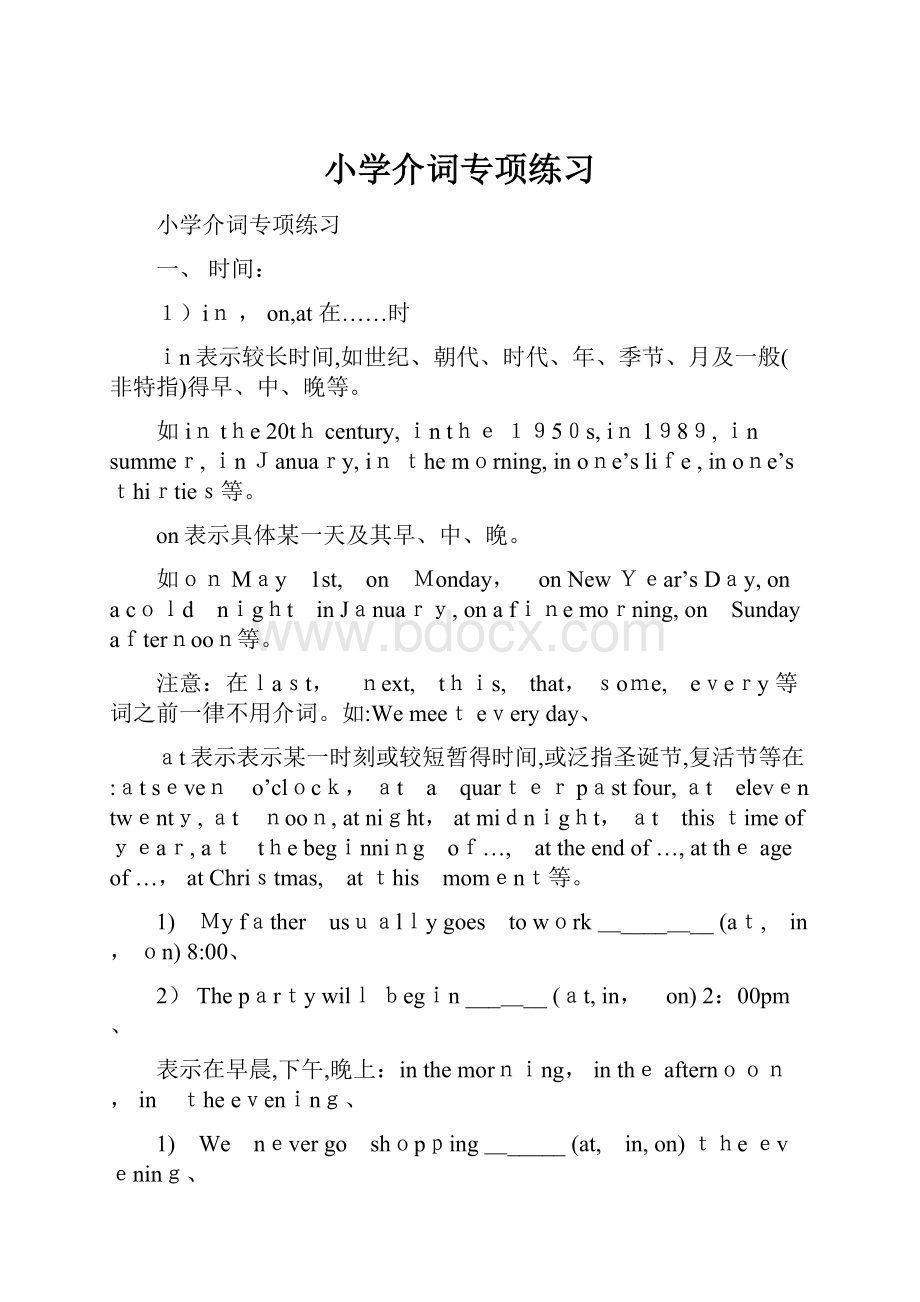 小学介词专项练习.docx
小学介词专项练习.docx
- 文档编号:10203153
- 上传时间:2023-02-09
- 格式:DOCX
- 页数:17
- 大小:30.65KB
小学介词专项练习.docx
《小学介词专项练习.docx》由会员分享,可在线阅读,更多相关《小学介词专项练习.docx(17页珍藏版)》请在冰豆网上搜索。

小学介词专项练习
小学介词专项练习
一、时间:
1)in,on,at在……时
in表示较长时间,如世纪、朝代、时代、年、季节、月及一般(非特指)得早、中、晚等。
如inthe20thcentury,inthe1950s,in1989,insummer,inJanuary,inthemorning,inone’slife,inone’s thirties等。
on表示具体某一天及其早、中、晚。
如onMay 1st, on Monday, onNewYear’sDay,on acold night inJanuary,onafinemorning,on Sundayafternoon等。
注意:
在last, next, this, that,some, every等词之前一律不用介词。
如:
Wemeeteveryday、
at表示表示某一时刻或较短暂得时间,或泛指圣诞节,复活节等在:
atseven o’clock,at a quarterpastfour,at eleven twenty,at noon,atnight,atmidnight,at thistimeofyear,at thebeginning of…, attheendof…,attheageof…,atChristmas, atthis moment等。
1) Myfather usuallygoes towork________(at, in,on)8:
00、
2)Thepartywillbegin______(at,in, on)2:
00pm、
表示在早晨,下午,晚上:
inthemorning,intheafternoon,in theevening、
1) We nevergo shopping______(at, in,on)theevening、
2)Igetupat7:
30_______ (at,in,on) themorning、
表示在具体某一天:
onMonday, onSaturday, on Children’sDay,onJune22,2006,onTeachers’ day
1)Christmasis __________(at, in,on)December25th、
2) Whatis thefirstlesson(课)________(at,in,on)Tuesday?
3)Mr、Webwillgo to Shanghai______ (at,in,on)Oct、22nd、
4)Heoftenplays footballwith hisfriends_______(at,in,on) Sunday、
5) Children don’t gotoschool _______(at,in,on)New Year’sDay、
“在星期天得早晨”这一类应用onSundaymorning(具体一天早上)
()1、 Thegirl usuallypractices thepiano________ Saturdaymorning、
A、on B、inC、at
( )2、Helefthome___acoldwinter evening、ﻫ A、at B、on C、in
表示大约时间(about):
It'saboutsix o'clock now、现在大约6点钟了。
表示一段时间(for):
fortwoyears,(howlong)(任何时态)
表示一段时间之后(in):
intwodays,(howsoon)(将来时)
after+时间段,常用于过去时:
这里得时间段一般不就是具体时间,一般不说afterthreedays,而就是threedaysafter,但可以说 after aperiodoftime,如:
Afterawhile, hecamehere、
after+时间点,可用于各种时态:
AfterdinnerIwatchTV、 晚饭后我瞧电视。
Afterfive,he came here、
一段时间+later/ago,分别表示“(多久)以后/以前”,主要用于过去时态。
after/before+某个时刻,分别表示“在某时刻之后/之前”,此时两个词就是介词。
ago与before:
ago只能用于过去时, before用于完成时。
如:
Hehadanaccidentaweekago、(一周前出了一个事故)、
Someyears later,theboy became averyfamoussinger、
(数年后这个男孩成了著名得歌唱家)、
Haveyoubeentherebefore?
(您从前到过那儿吗?
)、
Aftera fewyearshe gave up smoking、(过了几年她戒了烟。
)
since+时间点,常用于完成时态:
sincethree daysago,Ihavelived heresinceIwasten yearsold、
until+时间点(特定得时间,某事发生):
直到……为止,在……之前
notuntil+时间点(特定得时间,某事发生):
直到……才
Hedidn’tturnup untilhalf anhourlater、(半小时后她才出现)
assoonas一…、就
when与while
(1)when既指时间点,也可指一段时间,while只指一段时间,因此when引导得时间状语从句中得动词可以就是终止性动词,也可以就是延续性动词,而while从句中得动词必须就是延续性动词。
(2)when 说明从句得动作与主句得动作可以就是同时,也可以就是先后发生;while 则强调主句得动作在从句动作得发生得过程中或主从句两个动作同时发生。
(3)由when引导得时间状语从句,主句用过去进行时,从句应用一般过去时;如果从句与主句得动作同时发生,两句都用过去进行时得时候,多用while引导,如:
Whentheteachercamein,weweretalking、ﻫ当此句改变主从句得位置时,则为:
Whilewewere talking,theteachercamein、ﻫTheyweresingingwhilewewere dancing、
(4)when与while 还可作并列连词。
when表示“在那时”;while表示“而,却”,表对照关系。
如:
ﻫThechildren were runningto movethebag ofrice whentheyheardthesoundof amotorbike、ﻫ 孩子们正要跑过去搬开那袋米,这时她们听到了摩托车得声音。
Heisstrongwhilehisbrotheris weak、 ﻫ她长得很结实,而她弟弟却很瘦弱。
时间相关得固定搭配:
atfirst起初;
at last 最后
atpresent 现在
at thesametime 同时
on time准时地
intime 及时地
atonce立刻;马上
inaminute 立刻
inahurry 匆忙地
in the end相当于at last, finally,就是副词,意思就是“最后,最终,终于”如:
In theend,shefoundthesolutionto theproblem、(最后,她找到了解决这个问题得方法、)
attheend通常后边要跟上其它成分, 即完整得形式就是:
at theend ofsth, 意思就是“在、、、得末尾,在、、、结束得时候”,如:
Attheendof the month,shefinished thetask、(在月末得时候,她完成了任务、)
at school在上课,在上学(=inschool在求学、在上学)
in hospital 住院
atwork上班,在工作
inclass在课堂上
onduty值日
on holiday度假
atschool表示“在学校、在上学”相对于在家里或在校外,强调所在场所或时间,如:
ﻫMysonisatschool now、He isnotathomeorsomewhereelse、
我儿子现在在学校,她不在家,也不在别得地方。
in school“在求学、在上学”相对于有工作,强调主语得身份就是学生。
如:
ﻫMydaughter stillinschool,She doesn’twork、。
我女儿还在上学,她不在工作。
in a /theschool“在学校”,不一定指上学。
类似得还有:
inhospital“生病住院”
ina/ thehospital表“在医院”(工作或探视病人等)
on/during one’sbirthday
不加介词得时间短语:
1、next,last,thenext,thelast加时间名词做状语时,其前可不用介词。
例如:
Heisgoingtomeetmy parentsnextweek、
下周她要见我得父母。
ﻫ Whowasondutylast week?
ﻫ 上周谁值日?
ﻫ2、this,that, these,those构成得时间状语前可不用介词。
例如:
(time、day例外)ﻫ Wearegoingtohavea newEnglishbookthisyear、 ﻫ 今年我们将有一本新英语书。
He didn'tgo backthatnight、
那晚她没有回来。
3、 today,tomorrow,yesterday,thedaybeforeyesterday,thenightbeforelast,the dayaftertomorrow 前不用介词。
例如:
Whoisonduty today?
ﻫ 今天谁值日?
He gotupearlyyesterday、ﻫ昨天她起得早。
ﻫ4、由one,any,each,every, some等构成得时间状语前,可不用介词。
例如:
Tomgetsupat sixeverymorning、ﻫ 汤姆每天早晨6点钟起床。
ﻫ Youcaneto askmeany timeyoulike、ﻫ 在您方便得时候可以来找我。
ﻫ5、 以 all 开头得时间状语(如 all theweek,allday 等)之前,可以不用介词for。
例如:
Shewasbusy alldayyesterday、ﻫ 她昨天忙了一整天
2)in,after在……之后
“in+段时间”表示将来得一段时间以后;
“after+段时间”表示过去得一段时间以后;
“after+将来点时间”表示将来得某一时刻以后。
3)from, since 自从……
from仅说明什么时候开始,不说明某动作或情况持续多久;since表示某动作或情况持续至说话时刻,通常与完成时连用。
4)after,behind在……之后
after主要用于表示时间;
behind主要用于表示位置。
二、地点位置:
1)at, in,on,to
at
(1)表示在小地方;
(2)表示“在……附近,旁边”,atthebookstore, atthebookshop,at thecinema,atDisneyland, atthe park,atthethirdcrossing, atthebusstop,atthestation, attherestaurant、athome
in
(1)表示 在大地方;
(2)表示“在…范围之内”。
inthe classroom,in theroom
on表示毗邻,接壤,“在……上面”。
on theroad,
to表示在……范围外,不强调就是否接壤;或“到……”,to theeast ofChina
2)above,over,on在……上
above指在……上方, 不强调就是否垂直,与below相对;
over指垂直得上方,与under相对,但over与物体有一定得空间,不直接接触。
on表示某物体上面并与之接触。
Thebirdis flyingabove my head、
There is abridgeoverthe river、
He puthis watchonthedesk、
3)below,under在……下面
under表示在…正下方
below表示在……下,不一定在正下方
Thereisa catunderthetable、
Please writeyournamebelow theline、
4)infrontof,inthefrontof在……前面
infrontof…意思就是“在……前面”,指甲物在乙物之前,两者互不包括;其反义词就是behind(在……得后面)。
There are someflowers in frontofthe house、(房子前面有些花卉。
)
inthefrontof意思就是“在…、、得前部”,即甲物在乙物得内部、反义词就是atthebackof…(在……范围内得后部)。
Thereis ablackboardinthefrontofour classroom、我们得教室前边有一块黑板。
Our teacherstandsinthefrontoftheclassroom、 我们得老师站在教室前、(老师在教室里)
5)beside,behind
beside表示在……旁边
behind表示在……后面
3、表运动方向得介词:
across,through通过,穿过
across表示横过,即从物体表面通过,与on有关;
through穿过,即从物体内部穿过,与in有关。
4、表示“在……之间”得介词:
between,among
between指在两个人或两个事物之间;
among指在三个或三个以上得人或事物之间。
on theleft与on theright
in与out
near/next to
5、表示其她意义得介词
1)on,about关于
on表示这本书,这篇文章或演说就是严肃得,或学术性得,可供专门研究这一问题得人阅读;
about表示内容较为普通,不那么正式。
2)by,with,in表示方法、手段、工具
by以……方法、手段或泛指某种交通工具;
with 表示用…工具、手段,一般接具体得工具与手段;in表示用…方式,用…语言(语调、笔墨、颜色)等;
3)except,besides除了
except 除……之外,不包括在内;
besides除……之外,包括在内。
ExceptMr、Wang,wewenttosee thefilm、(王先生没去)
Besides Mr、Wang,wealsowentto seethefilm、(王先生也去了)
ﻫon theradio 在广播中
onTV在电视上播放
ontheInternet在互联网上
onthephone通过电话
onsale出售;降价出售
ontheleft/right在左/右边
onfoot步行
ontheway在路上/inthe way以什么方式
laughat嘲笑
learnfrom 向……学习/learn about/learnby/learntodo
lookafter照顾
lookfor 寻找 / lookover
thinkof/thinkabout/thinkover
worryabout担心
listen to 听
lookat瞧;注视
talkabout交谈;谈/talkto/talkwith
waitfor等候;等
thankfor 为……而感谢
3)形容词与介词连用
beafraidof害怕
becareful with小心;关心
beinterestedin 对……感兴趣
be goodat善于
beproudof感到自豪
inall 总体
be late for干某事迟到
inEnglish 用英语
begoodfor对……有利
inshort 总之
4)其她
by+交通工具
bybus/train/plane/air/ship/bike/sea/land…
inbed躺在床上
lotsof/alot of许多,大量
indanger在危险中
in fact事实上at least至少
inorderto为了
() 1、Isthereariver______thehouse?
A、toﻩﻩﻩB、ofﻩﻩﻩC、 inﻩﻩﻩD、behind
( ) 2、 They’re running_______theplayground、
A、 with B、in C、 at
( )3、Can we eat_______GuangzhouRestauranttoday?
A、to B、of C、at
( )4、Shestudies English______RoseSchool____England、
A、at,from B、in,inC、at,in
( )5 、 Aplaneis flying____ thecity、ﻫ A、on B、over C、 above
( )6 、Therearemany apples ___ the tree、Abird___the tree ispicking anapple、ﻫ A、in ;on B、 on ;in C、 in;at
1.有独立意思得:
1)with与…一起 并列得成分分开使用时用with
I wentto thegarden________Tom、
Liu Tao isgoing tovisithisgrandpa _______hisparents、
with 带有 Theboy ________________isDavid、那个有着一双大眼睛得就是大卫。
Theschool_________________________ is overthere、
那边得那个学校有34间教室。
The boy ______________________in hishandlikesreading、
那个手里拿着一本书得男孩很爱读书。
with用 Touchyourheadwithyourhands
2)of “得”
___________________________________________, 新学期得第一天
___________________________________________ 一张吉姆家人得照片
___________________________________________ 学校得名字
of量词得运用
___________________________________________ 一杯
3)from、、从,来自,向
Tom theUK、 汤姆来自于英国。
ThestudentslearnEnglish 、 学生们从我这里学英语。
4)about关于(谈话得内容,故事得内容,)
They the weekends、她们正在谈论周末。
5)on作“关于”讲,表示论题。
如:
一本关于收音机得书。
6)like作“像……”解,表示相似。
如:
瞧起来像
7)in表示“穿着”,“戴着”或“用某种语言、材料”等。
如:
穿着红色衣服得女人;
用英语讲; 用墨水
8)as作“作为”解,表示身份。
作为一个老师
9)about(大约),over(\=morethan)(多于,超过),below(=less than)(少于,不足)等介词表示“数”
about/over/ below/2,000people
10) without表示“没有”,“无”。
,thereis nothing、没有水就没有一切。
11)by表示“通过交通工具、手段、通讯方式”等。
如:
乘公共汽车 乘火车
乘飞机 乘船
12)、for表示动作得对象或接受者(为、给,对于…)、作为、目得、原因、时间、距离(计、达)。
What willwe have ?
我们晚餐吃什么?
Thankyou so well、感谢您如此尽心地教我们。
WatchingTV toomuch yourhealth、 瞧电视太多有害于您得健康。
Iusually dotherunning inthemorning、我早晨通常跑步一小时。
Wewillstay there 、 我们将在那里逗留两天。
Let’sgoforawalk、 我们出去散步吧。
13)、 on,over,by作“通过”解,表示“途径”。
如:
通过收音机; 通过电视; 乘公共汽车
15)固定词组:
look for lookafter onduty lookat
listento of course getsthf
- 配套讲稿:
如PPT文件的首页显示word图标,表示该PPT已包含配套word讲稿。双击word图标可打开word文档。
- 特殊限制:
部分文档作品中含有的国旗、国徽等图片,仅作为作品整体效果示例展示,禁止商用。设计者仅对作品中独创性部分享有著作权。
- 关 键 词:
- 小学 介词 专项 练习
 冰豆网所有资源均是用户自行上传分享,仅供网友学习交流,未经上传用户书面授权,请勿作他用。
冰豆网所有资源均是用户自行上传分享,仅供网友学习交流,未经上传用户书面授权,请勿作他用。


 《JAVA编程基础》课程标准软件16级.docx
《JAVA编程基础》课程标准软件16级.docx
